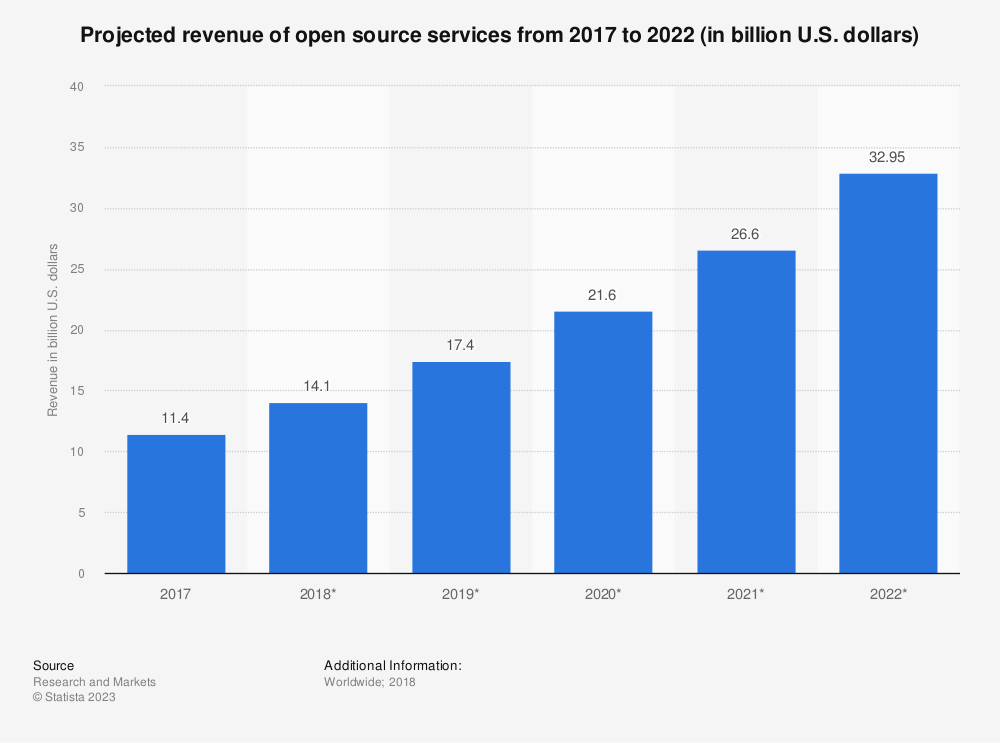In this second post of the “Marketing an Open Source Project” series, I provide a brief overview of what will be addressed in future posts and explain why this topic is so relevant for open-source communities.If you haven’t read the first article, you can find it here.
The open-source software (OSS) movement, while not new, has garnered significant recognition in recent years, even from former skeptics like Microsoft, which now actively embraces it. However, the OSS approach poses fresh challenges to conventional business models, particularly in governance and marketing.
Two primary OSS business ecosystems exist [1]: vendor-driven, where a corporation governs the OSS with centralized power, and community-driven, where power is radically decentralized, blurring lines between consumers and producers. The OSS sector has rapidly evolved into a substantial market. Open-source services reached a total revenue of 11.4 billion U.S. dollars (USD) in 2017 [2].

Considering that the number of available developers and experts in the market is limited, the challenge that OSS communities must face to attract new contributors and maintain the existing ones should not be underestimated. Therefore, it is important to gain an in-depth understanding of marketing OSS community-driven projects.
Linux is perhaps the most prominent OSS. Linux programmers contribute their knowledge and skills and give away the operative system. There are no shareholders to compensate and no formal organisation in the traditional sense to control. Although Linux is an OSS project, it is also a brand like any other. It fulfils the same functions to its users that other brands do.
Marketing is not free, and OSS communities usually do not carry a large amount of funding (most of the contributions are voluntary or sponsored by a company). A possible solution to gather the needed resources is to involve a firm that invests the money to do marketing in the project. However, empirical evidence has shown that firms’ involvement in OSS projects increases the popularity of the project in the short-term, but decreases the software quality, creating long-term issues that might end up destroying the project [3].
OSS communities often resist marketing, fearing commercialization, but they are, in essence, selling ideas and seeking valuable contributions of time and knowledge.
“Open source software communities are also selling. They are selling ideas, and in exchange, they ask for something extremely valuable: people’s time and knowledge” – Straughan, D. [4].
This research delves into barriers to marketing in community-driven OSS projects and aims to provide strategies for overcoming them. The study employed qualitative research methods, including online interviews, to gain insights into the motivations, barriers, and potential solutions for marketing in this unique ecosystem.
Next week, I will present a literature review to provide a deeper understanding of the topic at hand. Stay tuned for more!
References:
[1] Groganz, S., 2012. opensource. [Online]
Available at: https://opensource.com/business/12/9/a-complete-guide-marketing-project-business
[Accessed 09 15 2023].
[2] Research and Markets. (February 1, 2018). Projected revenue of open source services from 2017 to 2022 (in billion U.S. dollars) [Graph]. In Statista. Retrieved September 15, 2023, from https://www-statista-com.fontys.idm.oclc.org/statistics/270805/projected-revenue-of-open-source-software-since-2008/
[3] Capra, E., Francalanci, C., Merlo, F. & Rossi-Lamastra, C., 2011. Firms’ involvement in Open Source
projects: A trade-off between software structural quality and popularity. Journal of Systems and
Software, Volume 84, p. 144–161.
[4] Straughan, D., 2017. How to Market an Open Source Project. Los Angeles, Open Source Summit.
